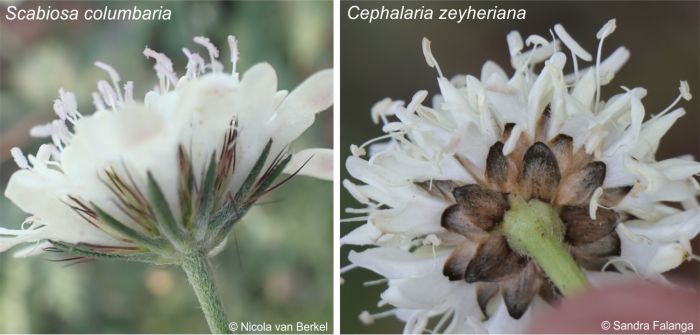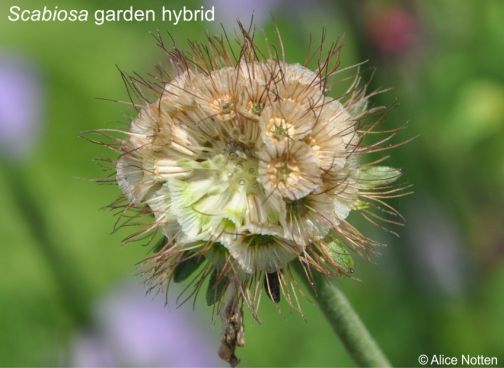Scabiosa genus
Scabiosa L.
Family: Dipsacaceae
Common names: scabious, scabiosa, pincushion
Introduction
Scabiosas breathe life into the open grasslands with their flowers that come in a variety of colours, such as lavender blue, pale mauve, purple, and white.

Description
Description
Scabiosas are herbaceous annuals or perennials, with flowering stems that are erect to suberect. Leaves are often different on the same plant, margins can be entire or deeply lobed. Inflorescences are of capitate flower heads, often on long peduncles. Involucral bracts are foliage-like, shorter or longer than the flowers. Calyx often has 5 bristles that are persistent into the fruiting stage. Flowering time is in summer, from August to February or late March. Fruit is a dry nutlet. Scabiosa seeds take approximately three weeks to germinate, and they usually flower during the same year (Van der Walt 2000).
Scabiosa L. is easily confused with Cephalaria Schrad. the former with involucral bracts that are foliaceous (leaf-like), and the calyx made up of persistent bristles, whereas the involucral bracts of the latter are somewhat dry, thin and membranous, and the calyx lacks bristles.

The genus Scabiosa was established in 1753 by Carolus Linnaeus (1707-1778), the father of binomial nomenclature. The generic name is derived from the Latin word, scabiosus, meaning ‘itchy or rough’ (Quattrocchi 1999). Species within this genus were believed to have medicinal properties for curing scabies, a skin condition that is caused by a parasitic mite (Quattrocchi 1999).
Conservation Status
Status
All but one of the South African species of Scabiosa are Red Listed as Least Concern (LC) and are not threatened. One species, Scabiosa transvaalensis is assessed as Vulnerable (VU).
Distribution and habitat
Distribution description
Scabiosa comprises ± 68 species, endemic to Europe, Asia, and eastern and southern Africa, with its greatest diversity primarily in the Mediterranean region (Carlson et al. 2012). The species occur in montane or steppe grasslands, with some exceptions to several European species that thrive in dry, rocky soils of the Mediterranean Basin (Carlson et al. 2012).
In southern Africa, 9 species are currently accepted, and a taxonomic review of the genus is in progress by Ramagwai (pers. comm. 2023). The ongoing review is likely to increase the number of recognised species, especially considering taxonomically complex ones such as S. columbaria L.
In South Africa, the genus Scabiosa primarily occurs along the coastal summer-rainfall provinces of the Eastern Cape, where species diversity is concentrated, and KwaZulu-Natal. It also occurs in the coastal winter-rainfall Western Cape. Additionally, it is found in the interior parts of summer-rainfall provinces of Limpopo, North West, Gauteng, Mpumalanga, Free State and Northern Cape. It extends into Lesotho and Eswatini as well.

Ecology
Ecology
Bombus Latreille (bumble-bee) and Syrphidae Latreille (hoverflies) were observed by Kwak (1993) in the wild and at the experimental garden in The Netherlands, pollinating Scabiosa columbaria. A postulation could be made that the same taxa might potentially pollinate other species within the genus. In Kirstenbosch National Botanical Garden in South Africa, a variety of butterflies as well as bees and beetles are frequently observed visiting the flowers of scabiosas cultivated in the garden, including Scabiosa africana, S. drakensbergensis and S. incisa. The radiate inflorescence typical of the genus is composed of individual flowers, each one protected by an epicalyx and calyx. The epicalyx and calyx collectively function as dispersal unit for the seeds (Caputo 2004). Scabiosa species are believed to be adapted for wind dispersal and epizoochory (dispersal by attaching to the surface of animal furs) (Caputo 2004).

Uses
Use
Scabiosa species are used in traditional medicine all over the world. For example, S. columbaria roots are used to treat period pains, and the arial parts are used to treat diphtheria (Moteetee & Kose 2016; Rigat et al. 2007). Horticultural use is more common for the genus.

Growing Scabiosa genus
Grow
Species of this genus make excellent bedding plants or border plants and are best displayed when mass planted, as the spectacle of their flower heads could captivate any plant enthusiast. They also make rewarding container plants. Scabiosas can be cultivated from seeds or propagated by division, and perform best in well-drained, sandy loam soil, in full sun (Pienaar 1984).
Species

Scabiosa africana L.
Cape scabious, pincushion (Eng.). koringblom (Afr.)
Herbaceous perennial, flowering stems erect, leafy at the base, ±1 m high. Leaves radical, simple, shortly connate, oblanceolate, 40–90(–150)× (35–55) mm, soft textured, pubescent, irregularly toothed; upper cauline leaves reduced, undivided or lyrate to pinnatisect, with three or more lobes per side, terminal lobe lanceolate. Capitula up to 50 mm wide, flowers lavender blue, pale mauve, purple.
Flowering time: winter, spring and early summer (July to November).
Occurs on sheltered sandstone slopes of the Cape Peninsula in the Western Cape, growing in well-drained loam or sandy or rocky soils.

Scabiosa columbaria L.
perennial scabiosa, wild scabious (Eng.); bitterbos, bitterwortel (Afr.), tlhako-ea-pitsi, selomi, mamokhale, moholungoane (South Sotho); isilawu esikhulu, iyeza lamehlo, makgha (isiXhosa); ibheka (isiZulu)
Herbaceous perennial, flowering stems erect, leafy at the base, 0.15–1.2 m high. Leaves radical, simple, petiolate, ovate-lanceolate, 50–170 × 20–45 mm, glabrous or pubescent, entire or deeply lobed; upper cauline leaves reduced, entire, pinnate or pinnatipartite. Capitula up to 35 mm wide, flowers white, pink.
Flowering time: spring and summer (August to February).
Occurring on open grasslands and mountain slope of Europe, Asia, eastern and southern Africa, in well-drained loam or sandy or rocky soils.

Scabiosa incisa Mill.
coast scabious (Eng.), koringblommetjie (Afr.), isilawu esikhulu, iyeza lamehlo (isiXhosa)
Herbaceous perennial, flowering stems erect, leafy at the base, 0.43 m high. Leaves radical, lyrate-pinnatisect to bipinnatisect, petiolate, ovate-lanceolate, 50–70 × 10–15 mm, pubescent, deeply lobed; upper cauline leaves reduced, otherwise similar. Capitula up to 30 mm wide, flowers white or pink.
Flowering time: spring and early summer (September to November).
Occurring along the coastal sands, from Bokbaai to Makhanda (Grahamstown), frequent in limestone.
References
- Broddle, P. 2023. Observation of Scabiosa incisa, Ganzekraal Conservation Area, Western Cape. iNaturalist. Online: https://www.inaturalist.org/observations/98469973.
- Cannon, M.J. & Cannon, J.F.M. 1983. Dipsacaceae. In Launert, E. (Ed.), Flora zambesiaca 7(1): 77-85.
- Caputo, P., Cozzolino, S. & Moretti, A. 2004. Molecular phylogenetics of Dipsacaceae reveals parallel trends in seed dispersal syndromes. Plant Systematics and Evolution 246: 163-175.
- Carlson, S.E., Linder, H.P. & Donoghue, M.J. 2012. The historical biogeography of Scabiosa (Dipsacaceae): implications for Old World plant disjunctions. Journal of Biogeography 39(6): 1086-1100.
- Goldblatt, P. & Manning, J. 2000. Cape Plants. A conspectus of the Cape flora of South Africa. Strelitzia 9. National Botanical Institute, Pretoria & Missouri Botanical Garden, Missouri.
- Joffe, P. 1993. The gardener’s guide to South African plants. Tafelberg Publishers, Cape Town.
- Kwak, M.M. 1993. The relative importance of syrphids and bumblebees as pollinators of three plant species. Proceedings of the Section of Experimental and Applied Entomology of the Netherlands Entomological Society, Amsterdam, Vol. 4: 137-144.
- Falanga, S. 2023. Observation of Cephalaria zeyheriana, Pretoria NBG, Gauteng. iNaturalist. Online: https://www.inaturalist.org/observations/168311567.
- Manning, J. 2009. Field guide to wild flowers of South Africa. Struik Nature, Cape Town.
- Moteetee A, & Kose, L.S. 2016. Medicinal plants used in Lesotho for treatment of reproductive and post-reproductive problems. Journal of Ethnopharmacology 194: 827–849.
- Napper, D. M. 1968. Dipsacaceae. In Milne-Redhead, E. & Polhill, R.M. Flora of Tropical East Africa. Crown Agents for Overseas Governments and Administration, London.
- Pienaar, K. 1984. The South African what flower is that? Struik, Cape Town.
- Pooley, E. 1998. A field guide to wild flowers Kwazulu-Natal and the eastern region. Natal Flora Publications Trust, Durban.
- Quattrocchi, U. 1999. CRC World Dictionary of plant names: common names, scientific names, eponyms, synonyms, and etymology. CRC Press, New York.
- Raimondo, D., Von Staden, L., Foden, W., Victor, J.E., Helme, N.A., Turner, R.C., Kamundi, D.A. & Manyama, P.A. (eds) 2009. Red list of South African plants. Strelitzia 25. South African National Biodiversity Institute, Pretoria.
- Rebelo, T. 2023. Observation of Scabiosa africana, Table Mountain National Park, Western Cape. iNaturalist. Online: https://www.inaturalist.org/observations/188263380.
- Rigat, M., Bonet, M.À., Garcia, S., Garnatje, T. & Vallès, J. 2007. Studies on pharmaceutical ethnobotany in the high river Ter valley (Pyrenees, Catalonia, Iberian Peninsula). Journal of Ethnopharmacology 113(2): 267-277.
- Van Berkel, N. 2023. Observation of Scabiosa columbaria, Signal Hill, Western Cape. iNaturalist. Online: https://www.inaturalist.org/observations/191477277.
- Van der Walt, L. 2000. Scabiosa africana L. (Dipsacaceae). PlantZAfrica. Online: https://pza.sanbi.org/scabiosa-africana.
Credits
Mulweli Maswoliedza
Foundational Biodiversity Science
December 2023
Acknowledgements: the author is grateful to John Manning, Alice Notten and iNaturalist observers for sharing their photographs.
Plant Attributes:
Plant Type: Perennial
SA Distribution:
Soil type:
Flowering season:
PH:
Flower colour:
Aspect:
Gardening skill:
Special Features:
Horticultural zones






Rate this article
Article well written and informative
Rate this plant
Is this an interesting plant?
Login to add your Comment
Back to topNot registered yet? Click here to register.